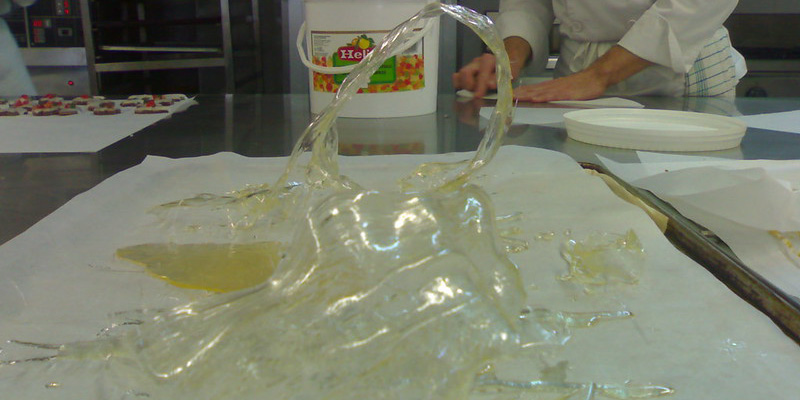guide to different sugars:
isomalt

- 2 cups isomalt
- 1/2 cup water
Comprehensive Look at Different Sugars or Sweeteners and Their Uses: Isomalt
By Renee Shelton
Isomalt is a chemically-produced sugar substitute perfect for candy-making because it creates a more humidity- and moisture-resistant product. And because it does a great job of resisting crystallization on its own, isomalt doesn't need any anti-crystallizing ingredients when boiling like some sugar syrups using granulated sugar call for.
Isomalt is sugar-free and lower in calories than regular sugar, but is also made from sucrose. Isomalt along with similar sugar replacers are termed 'polyols'. While they are carbohydrates, they are not a sugar; they are sugar alcohols. Isomalt doesn't promote tooth decay the way standard sugar does. While perfect for people who are on sugar-restricted diets, if eaten in large quantities, or for people with sensitive systems, it can cause gastric upset like gas or give a laxative effect.
Isomalt can be used in much the same way as regular sugar, such as making candies, using it as an ingredient in baked items, and sweetening products. While it is versatile, it will not brown like sugar. Because of all the properties listed above (humidity/moisture resistant, anti-crystallization properties, doesn't brown like sugar) it is excellent for blown sugar and boiled sugar art work.
Basic Isomalt Recipes
Isomalt syrup is convenient for use in blown sugar work, candy jewels, or cast sugar work. A basic recipe will consist of boiling isomalt and water together to reach 320 to 340 degrees. Some recipes call for water to be optional like this recipe from Squire's Kitchen in the UK - melt 500g isomalt over low heat. Once melted add in 60g liquid glucose and boil until 180 degrees C.
If you are adding water, a typical recipe consists of 4 parts isomalt to 1 part water, like the recipe below. Note when working with isomalt as with all blown sugar work - the end product is very hot and sugar gloves are a necessary precaution.
Mix the isomalt and water together. Wash down the sides if necessary, and bring to a boil over medium high heat. Cook until temperature reaches 340 degrees F. If coloring is to be added, add food coloring when the temperature reaches 280 degrees F, then continue cooking. Plunge the bottom of the pot in cool water to stop the cooking, then proceed with the sugar art.
- "Isomalt." Polyol.org, 2011. Web. 4 December, 2011.
- "SK Isomalt Specialist Sugar." Squires-shop.com. Squires Kitchen Ltd., n.d. Web. 4 December, 2011.
- Whittington, Vi. Cooked Sugar Art. Country Kitchen SweetArt, Inc., 2009.
Sources:
This article was first published on pastrysampler.com on January 8, 2011. It was updated on September 29, 2020.
Image "Imagen310" by Javi Vte Rejas is licensed under CC BY 2.0.
